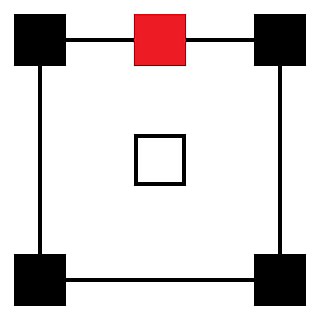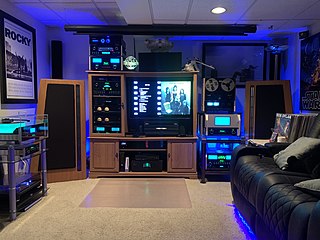Dolby Digital, originally synonymous with Dolby AC-3, is the name for a family of audio compression technologies developed by Dolby Laboratories. Called Dolby Stereo Digital until 1995, it is lossy compression. The first use of Dolby Digital was to provide digital sound in cinemas from 35 mm film prints. It has since also been used for TV broadcast, radio broadcast via satellite, digital video streaming, DVDs, Blu-ray discs and game consoles.

Quadraphonic sound – equivalent to what is now called 4.0 surround sound – uses four audio channels in which speakers are positioned at the four corners of a listening space. The system allows for the reproduction of sound signals that are independent of one another.

Surround sound is a technique for enriching the fidelity and depth of sound reproduction by using multiple audio channels from speakers that surround the listener. Its first application was in movie theaters. Prior to surround sound, theater sound systems commonly had three screen channels of sound that played from three loudspeakers located in front of the audience. Surround sound adds one or more channels from loudspeakers to the side or behind the listener that are able to create the sensation of sound coming from any horizontal direction around the listener.
Dolby Pro Logic is a surround sound processing technology developed by Dolby Laboratories, designed to decode soundtracks encoded with Dolby Surround. The terms Dolby Stereo and LtRt are also used to describe soundtracks that are encoded using this technique.
Matrix decoding is an audio technology where a small number of discrete audio channels are decoded into a larger number of channels on play back. The channels are generally, but not always, arranged for transmission or recording by an encoder, and decoded for playback by a decoder. The function is to allow multichannel audio, such as quadraphonic sound or surround sound to be encoded in a stereo signal, and thus played back as stereo on stereo equipment, and as surround on surround equipment – this is "compatible" multichannel audio.

DTS, Inc. is an American company. DTS company makes multichannel audio technologies for film and video. Based in Calabasas, California, the company introduced its DTS technology in 1993 as a competitor to Dolby Laboratories, incorporating DTS in the film Jurassic Park (1993). The DTS product is used in surround sound formats for both commercial/theatrical and consumer-grade applications. It was known as The Digital Experience until 1995. DTS licenses its technologies to consumer electronics manufacturers.
Founded by David Hafler and Ed Laurent in Philadelphia, Pennsylvania in 1955, Dynaco was an American hi-fi audio system manufacturer popular in the 1960s and 1970s for its wide range of affordable, yet high quality audio components.. Its best known product was the ST-70 tube stereo amplifier. They also manufactured other tube and solid state amplifiers, preamplifiers, radio tuners and bookshelf loudspeakers. Dynaco was liquidated in 1980, and the trademark is now owned by Radial Engineering Ltd.
Dolby Stereo is a sound format made by Dolby Laboratories. It is a unified brand for two completely different basic systems: the Dolby SVA 1976 system used with optical sound tracks on 35mm film, and Dolby Stereo 70mm noise reduction on 6-channel magnetic soundtracks on 70mm prints.
David Hafler was an American audio engineer. He was best known for his work on an improved version of the Williamson amplifier using the ultra-linear circuit of Alan Blumlein.

An audio/video receiver (AVR) is a consumer electronics component used in a home theater. Its purpose is to receive audio and video signals from a number of sources, and to process them and provide power amplifiers to drive loudspeakers and route the video to displays such as a television, monitor or video projector. Inputs may come from a satellite receiver, radio, DVD players, Blu-ray Disc players, VCRs or video game consoles, among others. The AVR source selection and settings such as volume, are typically set by a remote controller.

SQ Quadraphonic was a matrix 4-channel quadraphonic sound system for vinyl LP records. It was introduced by CBS Records in 1971. Many recordings using this technology were released on LP during the 1970s.
Ambiophonics is a method in the public domain that employs digital signal processing (DSP) and two loudspeakers directly in front of the listener in order to improve reproduction of stereophonic and 5.1 surround sound for music, movies, and games in home theaters, gaming PCs, workstations, or studio monitoring applications. First implemented using mechanical means in 1986, today a number of hardware and VST plug-in makers offer Ambiophonic DSP. Ambiophonics eliminates crosstalk inherent in the conventional stereo triangle speaker placement, and thereby generates a speaker-binaural soundfield that emulates headphone-binaural sound, and creates for the listener improved perception of reality of recorded auditory scenes. A second speaker pair can be added in back in order to enable 360° surround sound reproduction. Additional surround speakers may be used for hall ambience, including height, if desired.

Center channel refers to an audio channel common to many surround sound formats. It is the channel that is mostly, or fully, dedicated to the reproduction of the dialogue of an audiovisual program. The speaker(s) connected to the center channel are placed in the center of and behind the perforated projection screen, to give the effect that sounds from the center channel are coming from the screen. In many home surround sound units, the center channel is positioned above or below the video screen.

Home audio refer to audio consumer electronics designed for home entertainment, such as integrated systems like shelf stereos, as well as individual components like loudspeakers and surround sound receivers.
Realistic is a brand produced by RadioShack, a division of Tandy Corporation, to market audio and video products for home use. The brand name was phased out in the mid 1990s and discontinued in 2000, then returned briefly in 2016.

Quadraphonic Sound was a phase amplitude matrix 4-channel quadraphonic sound system for phonograph records. The system was based on technology created by Peter Scheiber, but further developed by engineer Ryosuke Ito of Sansui in the early 1970s.
Stereo-4, also known as EV or EV-4, was a matrix 4-channel quadraphonic sound system developed in 1970 by Leonard Feldman and Jon Fixler.

Dynaquad, or DY, was a matrix decoder 4-channel quadraphonic sound system developed by Dynaco in 1969.

UD-4 was a discrete four-channel quadraphonic sound system for phonograph records introduced by Nippon Columbia (Denon) in 1974. This system had some similarities with the more successful CD-4 process introduced by JVC and RCA in 1972.
Matrix H was developed by BBC engineers in the late 1970s to carry quadraphonic sound via FM radio in a way that would be most compatible with existing mono and stereo receivers.










